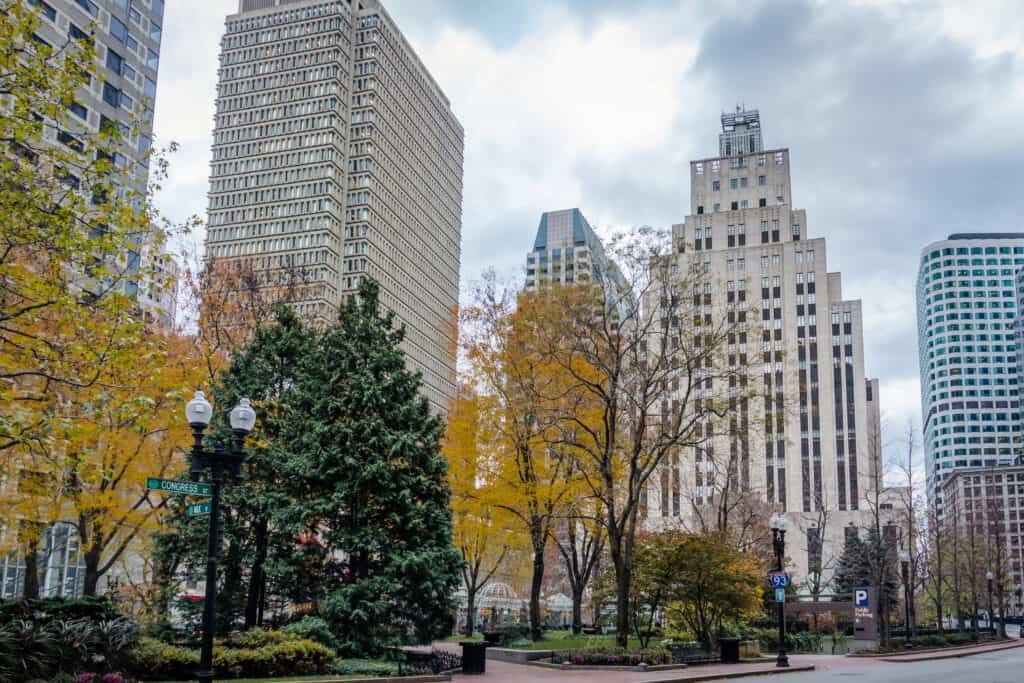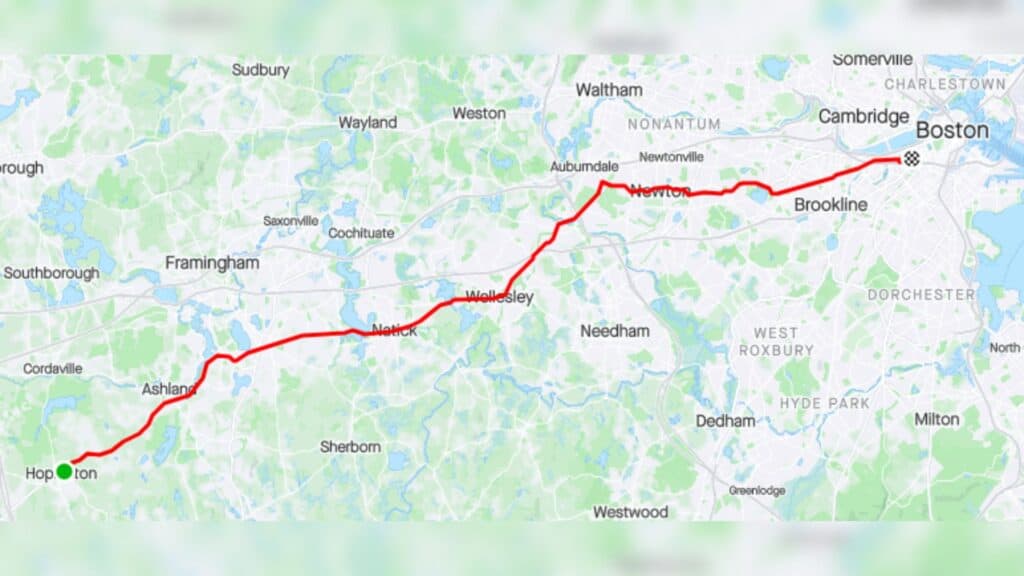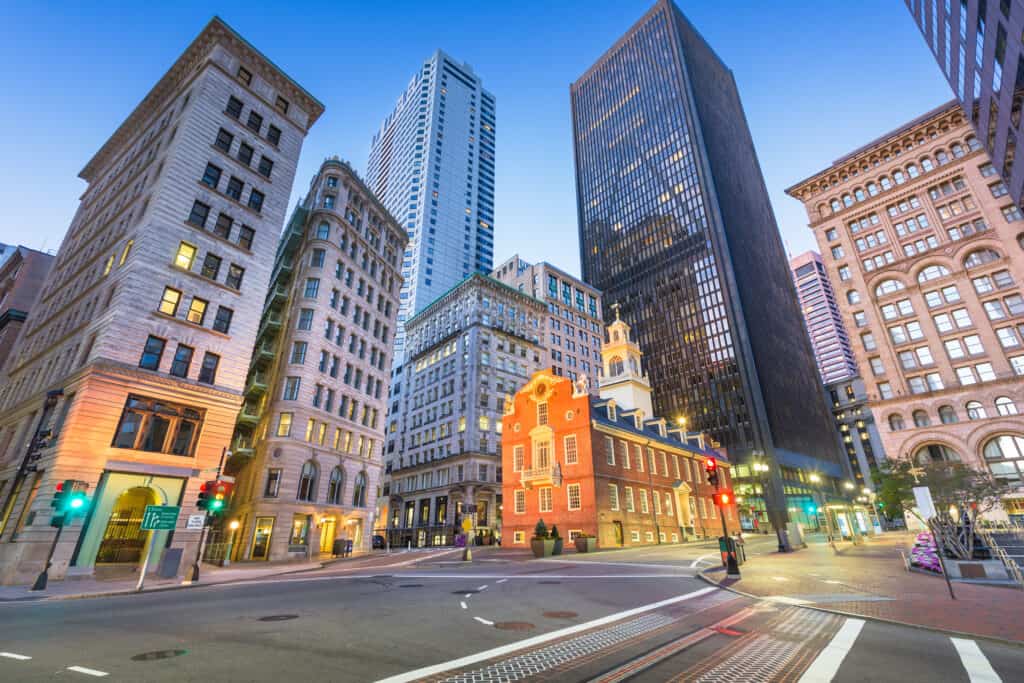The Boston Marathon is unlike any other race. Qualifying to participate adds a special level of prestige to this remarkable event that runners from all over the world aspire to be part of.
To earn a spot at the start line of the Boston Marathon 2026, you must meet strict qualifying time standards that vary based on your age and gender.
It’s not just a race; it’s a cherished tradition that holds deep meaning for the city and its people.
The 2013 bombings transformed the marathon into a symbol of strength and unity, showcasing the unwavering spirit of Boston.
If you’re gearing up for the next Boston Marathon, this is exactly what you need.
Here’s everything you need to know about the 2026 race. From registration details and costs to a description of the marathon route, we’ve got you covered. We’ll also share insights on how to effectively train for the Boston Marathon, ensuring you’re prepared for this incredible experience.

Before we dive into the details of how to enter the Boston Marathon in 2026, let’s first take a brief glimpse into the rich history of this iconic race.
- The Boston Marathon is the world’s oldest annual marathon, dating back to its inception in 1897.
- The race started because John Graham, the first U.S. Olympic manager, was inspired by what he witnessed at the Olympic Games in 1896. A year later, he formed the Boston Marathon (then only 24.5 miles long).
- The event was inspired by the success of the first marathon race in the 1896 Summer Olympics. A year later, John Graham, the first U.S. Olympic manager, formed the Boston Marathon (then only 24.5 miles long).
- The Boston Athletic Association (B.A.A.) has organized the marathon event every year since 1897, except in 2020 due to the COVID-19 pandemic.
- The marathon was originally only open to male runners, but in 1972, women were allowed to officially enter the race.
- Since then, the Boston Marathon has become one of the world’s most prestigious and iconic marathons.
When Is The 2026 Boston Marathon and How Much Does it Cost
The 2026 Boston Marathon is set to take place on Monday, April 20th.
Over the past few years, non-US residents have had a slightly higher registration rate than US residents.
As of the 2024 Marathon, The entry fee for accepted qualifiers will be $230 USD for United States residents and $235 USD for international residents. Participants will have the opportunity to purchase registration protection at the point of registration. Entry fees will only be processed once an athlete is accepted into the Boston Marathon.
The qualifying window for the 130th Boston Marathon, scheduled to take place on April 20, 2026, began on September 1, 2024. Registration details for that race will be announced following the 2025 Boston Marathon. To secure your place in this prestigious race, you’ll need to meet specific time standards based on your age and gender.
For more details, see “How To Enter Boston Marathon 2026: Cost, How, & Who Can.”
The entire registration process takes place conveniently online through the B.A.A.’s dedicated platform, Athletes’ Village.
Boston Marathon Accommodation: The BEST Hotels For Runners
How To Qualify For The 2026 Boston Marathon
To earn a spot in the prestigious Boston Marathon, you must meet strict qualifying time standards that vary based on your age and gender. These qualifying times are no walk in the park, demanding runners to maintain fast race paces.
For instance, male runners aged 18-34 must conquer the marathon in less than 3 hours, while female runners in the same age group have to finish in under 3 hours and 30 minutes. It’s a challenge that pushes athletes to their limits and sets the bar high for entry into this renowned race.
These strict time standards are in place to maintain the race’s high level of competition.
The qualifying window for the 2026 Boston Marathon opened on September 1, 2024 and will run through the end of registration next fall (dates to be announced).
Qualifying times may be used for multiple race registrations so long as the achieved qualifying time was run within the race’s specified qualifying window.
Participants will have the opportunity to purchase registration protection at the point of registration.
If your goal is to run the next Boston Marathon, it’s essential to train diligently and strive to meet the rigorous qualifying times set by the organizers.

What are the qualifying time standards for each age group?
Qualifying for the Boston Marathon is no small feat.
To ensure fairness and competitiveness, the Boston Athletic Association (B.A.A.) sets specific qualifying time standards for each age group.
These standards vary based on age and gender, reflecting the diverse range of participants. Let’s dive into the qualifying times across different age brackets.
To find out the specific qualifying times for your age group, refer to the table below.
| Age Group | MEN | WOMEN | NON-BINARY |
|---|---|---|---|
| 18-34 | 2hrs 55min 00sec | 3hrs 25min 00sec | 3hrs 25min 00sec |
| 35-39 | 3hrs 00min 00sec | 3hrs 30min 00sec | 3hrs 30min 00sec |
| 40-44 | 3hrs 05min 00sec | 3hrs 35min 00sec | 3hrs 35min 00sec |
| 45-49 | 3hrs 15min 00sec | 3hrs 45min 00sec | 3hrs 45min 00sec |
| 50-54 | 3hrs 20min 00sec | 3hrs 50min 00sec | 3hrs 50min 00sec |
| 55-59 | 3hrs 30min 00sec | 4hrs 00min 00sec | 4hrs 00min 00sec |
| 60-64 | 3hrs 50min 00sec | 4hrs 20min 00sec | 4hrs 20min 00sec |
| 65-69 | 4hrs 05min 00sec | 4hrs 35min 00sec | 4hrs 35min 00sec |
| 70-74 | 4hrs 20min 00sec | 4hrs 50min 00sec | 4hrs 50min 00sec |
| 75-79 | 4hrs 35min 00sec | 5hrs 05min 00sec | 5hrs 05min 00sec |
| 80 and over | 4hrs 50min 00sec | 5hrs 20min 00sec | 5hrs 20min 00sec |
Boston Marathon Qualifying Times: Can You Make the Cut?
You may be inspired by the fact that more than 30,000 athletes worldwide qualify for the Boston Marathon, making you believe that you can achieve it too.
To participate in the Boston Marathon, you must meet the qualification requirements within a 12-month period before the September registration date for the April race.
This implies that you need to attain a qualifying time between approximately 7 and 19 months before the April race.
Below, you can find the cut-off times from previous years. Notably, there was no cut-off time limit for the 2022 and 2023 Boston Marathons, meaning that all runners with a valid qualifying time were accepted into the race.
| YEAR | FIELD SIZE | “CUT-OFF TIME” | QUALIFIERS NOT ACCEPTED |
| 2012 | 27,000 | 1:14 | 3,228 |
| 2014 | 36,000 | 1:38 | 2,976 |
| 2015 | 30,000 | 1:02 | 1,947 |
| 2016 | 30,000 | 2:28 | 4,562 |
| 2017 | 30,000 | 2:09 | 2,957 |
| 2018 | 30,000 | 3:23 | 5,062 |
| 2019 | 30,000 | 4:52 | 7,248 |
| 2020 | 31,500 | 1:39 | 3,161 |
| 2021 | 20,000 | 7:47 | 9,215 |
If you’re curious about the exact start time for your particular wave, the Boston Athletic Association (B.A.A.) website has a countdown timer down to the second.
Elite runners typically kick off the race, so if you’re among them, you can expect to be among the first to hit the starting line.
Take a look at the starting times of the previous marathon to get a sense of when your wave is likely to begin.
| Division/Program | Starting Time |
| Women’s Wheelchair | 9:05 a.m. ET |
| Hand Cycles and Duos | 9:30 a.m. ET |
| Elite Women | 9:47 a.m. ET |
| Elite Men | 9:37 a.m. ET |
| Military March | 6:00 a.m. ET |
| Para Athletics Division | 9:50 a.m. ET |
| Wave One | 10:00 a.m. ET |
| Wave Two | 10:25 a.m. ET |
| Wave Three | 10:50 a.m. ET |
| Wave Four | 11:15 a.m. ET |
| Men’s Wheelchair | 9:02 a.m. ET |
In this article, Boston Marathon Qualifying Times: How Fast You Need To Run, I share some valuable tips on how you can improve your speed to decrease your running time. Be sure to give it a read!
Now that you’re aware of the qualifying times needed to secure a spot in this prestigious event, let’s take a look at a brief description of the marathon route.
For a detailed mile-mile breakdown of the Boston Marathon route, refer to “From Start to Finish: Boston Marathon Route Explained”
The Boston Marathon Route Description
The Boston Marathon Route is a 26.2-mile (42.2-km) course that starts in Hopkinton, Massachusetts, and finishes in Boston. The course has a net elevation loss of 459 feet (139.9 meters), with the highest point at the start and the lowest point at the finish.
The first half presents a series of gently rolling hills, setting the stage for an exhilarating run. Keep an eye out for a notable climb before reaching Wesley.
The second half of the course is known for its challenging hills, particularly the famous Newton Hills spanning roughly 25-30 km. The final stretch includes the feared Heartbreak Hill. However, the last few kilometers are mostly gentle downhill, leading runners to the finish line.
The Boston Marathon route is considered a difficult course, with its rolling hills and challenging terrain. The course records for men and women are 2:03:02 and 2:19:59, respectively.
Start Line to Mile 1
The race starts with a thrilling descent, but you should refrain from speeding up. At 800 meters, there is a minor ascent that takes some by surprise.
Mile 1 to Mile 4
The scenery changes from rural to commercial as the route continues with rolling hills. You’ll pass through famous landmarks such as the clock tower, as well as Massachusetts trademarks such as Dunkin’ Donuts and the “T” for the Ashland Commuter Rail station.
Mile 4 to Mile 10
The course enters Framingham and features mostly flat terrain and minor rolling hills. Runners will pass through industrial areas and enjoy the scenic Lake Cochichuate. The historic district of Natick makes a nice switch from commercial and industrial landscapes.
Mile 10 to Mile 16
This section takes you through Natick Centre, which attracts large crowds. The mile begins with an upward rise and gradually descends. As you near Wellesley College, you’ll pass through the famed Wellesley College screaming tunnel.
In 2023, I did not have a particularly good run, however, the scream tunnel at Wellesley College was a real highlight that lifted my spirits for a good few miles after.
Mile 16 to Mile 21
This is where the course becomes challenging with the start of the Newton Hills. Runners climb and descend for about nine miles, including the notable Heartbreak Hill. Boston College’s energetic supporters make their presence known, providing encouragement along the way.
Mile 21 to Mile 24
As the race enters Brookline, you will encounter rail tracks and a quarter-mile rise. Descending Beacon Street, you’ll pass past Brookline’s neighborhoods and catch a glimpse of Boston’s Citgo sign.
Mile 24 to Mile 26.2 (Finish Line)
The final stretch begins with a slight descent, offering a view of Fenway Park. Runners pass through enthusiastic crowds at “the turn on Hereford” and make their way to Boylston Street, where the finish line awaits near the Boston Public Library and Copley Square.
Boston Marathon Course Map

Boston Marathon Elevation Charts
You can design an effective race strategy by using the Boston Marathon elevation charts, which take into account the particular paces you should maintain according to the height variations along the route. This will assist you in meeting your Boston Marathon time target.

Boston Marathon GPX File
When it comes to planning and training for the Boston Marathon, having a GPX file of the course might be a great advantage.
This digital file can be uploaded to numerous platforms, such as Google Maps or a fitness watch, allowing runners to engage with and utilize the map to its maximum potential.
Using the GPX file, you can carefully examine the course and plan your race-day strategy.
Knowing the terrain and elevation changes ahead of time allows you to mentally and physically prepare for any challenges that may arise along the way.
The file can also give you a sense of security and confidence because it allows you to stay on track and track your progress throughout the race.
For your family and friends who would love to cheer you up from the sidelines, we’ve compiled a guide to the top spectator spots along the Boston Marathon route.
Top Spectator Spots along the Boston Marathon Route.

Attending the 2026 Boston Marathon Expo
The expo is a three-day event that features more than 200 exhibitors offering the latest in running apparel, shoes, accessories, nutrition, technology, and more.
The Boston Marathon Expo is one of the most anticipated events leading up to the Boston Marathon.
As the largest running expo in the country, the Expo provides an opportunity for runners to connect with fellow athletes, learn about the latest running gear and technology, and pick up their race bibs and other essentials.
Why You Should Attend The Expo?
Attending the Boston Marathon Expo is not only a great way to prepare for the race, but it is also a great way to meet other runners and fitness enthusiasts.
Runners can gain valuable insights, learn about new products and technologies, and connect with a supportive community of like-minded individuals by attending the Expo.
Furthermore, the Boston Marathon Expo serves as a reminder of the Boston Marathon’s incredible history and legacy, as well as the significance of this event not only to the running community but to the city of Boston and the entire world.
When Is The Boston Marathon Expo?
The Boston Marathon Expo takes place three days before the race, typically on the Friday, Saturday, and Sunday before Marathon Monday.
The expo’s hours of operation are usually from 9:00 a.m. to 7:00 p.m. on all three days. It is important to note that the expo closes promptly at 7:00 p.m., so plan accordingly.
The Expo is held at the John B. Hynes Veteran’s Memorial Convention Centre, located in the Back Bay neighborhood of Boston situated at 900 Boylston St.
How Do I Get To The Expo?
Public Transportation Options
Public transportation is the easiest and most convenient way to get to the Expo, with several subway and bus lines running nearby.
There are several ways to get to the expo by public transportation:
- Through the Green Line
- Through the Orange Line
- By Bus
Expo goers have several options for getting to the Hynes Convention Centre, including taking the Green Line to the Hynes Convention Centre station or the Copley station.
One convenient option is to take the Orange Line to the Back Bay station or the Commuter Rail to the Back Bay station, followed by a short walk to the convention center.
An alternative mode of transport to get to the expo is by bus, with routes 1, 9, 10, 39, 55, or CT1 stopping at the Hynes Convention Centre.
Driving Directions and Parking Information
If you prefer to drive to the expo, you should be aware that parking can be challenging and expensive in this area.
There are also numerous road closures, particularly during the Boston Athletic Association 5 km race. Check your route and parking options before departing on your journey.
The Hynes Auditorium Garage (Pilgrim Parking) offers convenient on-site parking, but spaces fill up quickly and can be expensive.
Numerous parking garages are available in proximity to the convention center. These include
- Prudential Centre Garage,
- Four Seasons One Dalton Valet (Propark),
- 102 Belvedere St Garage
- Central LAZ Parking
- Boston Marriott Copley Place Parking
You can also try to find street parking on Boylston Street or nearby streets, but be prepared to pay meters and follow parking regulations.
It’s important to note that parking fees can be steep, with rates ranging from $10-$30 per day.
In addition, special needs parking is available for those with disabilities, but it must be reserved in advance.
Not driving or taking public transport?
Alternative transportation options, such as biking or walking, may also be viable, depending on your location.
What to Expect at the Boston Marathon Expo
The Boston Marathon Expo is a vibrant and crowded event held at the Convention Centre. Runners and spectators flock to the Expo to collect their race bibs and other necessary items.
The Expo is not just about the essentials; it also offers a range of exhibitors and vendors who showcase the latest running gear and technology.
Moreover, attendees can participate in seminars and presentations throughout the day, where they can learn about training tips, nutrition, and hydration strategies, as well as injury prevention.
Exhibitors and Vendors
The Expo features a wide range of exhibitors and vendors from the running and fitness industries. You’ll find booths from major athletic brands like Nike, Asics, and New Balance, as well as smaller companies showcasing their latest products and innovations.
Some of the most noteworthy exhibitors at the Boston Marathon Expo in recent years include:
Make sure you don’t miss out on anything at the Expo! If you want to see a complete list of vendors and exhibitors, just take a look at this article, and you’ll find all the information you need, Boston Marathon Expo 2026: How to get there, Times, and Parking
But that’s not all! I also want to help you make the most of your time at the Expo. I’ve gathered some handy tips to guide you through the event, ensuring you have an amazing experience.
How To Train For The Boston Marathon
Training for the Boston Marathon typically involves more than just running. It includes several essential elements that serve as the foundation of your training plan.

These components are vital to your overall preparation and will contribute to your success in the marathon:
- Easy Runs
- Long Runs
- Strength and Conditioning
- Cross Training
- Nutrition
- Recovery Time
- Tapering
For ideal preparation, it is advisable to begin your training 16–20 weeks prior to the race day, allowing time to gradually build up your endurance and reach your peak performance.
This entails laying a solid foundation and running consistently for 4–8 weeks. You can then begin your Boston Marathon training 12 weeks before race day, which is typically in mid-January.
With that in mind, let’s briefly look at the Boston Marathon training plan.
Easy Runs
The key to easy runs is to keep a relaxed and conversational pace. It is critical to emphasize that “easy” means EASY.
These runs should not leave you out of breath or struggling for air; instead, they should allow you to comfortably converse with a running partner.
The primary purpose of easy runs is to develop the aerobic system, which plays a vital role in supplying energy at the submaximal effort.
These runs provide the opportunity for the body to adapt, repair, and strengthen the muscles, tendons, and ligaments while improving energy metabolism.
Running at an appropriate intensity strikes a balance between stimulating your aerobic capacity and allowing enough recovery time before your next difficult workout.
Long Runs
Long runs serve several functions, the primary one being to improve endurance and supply energy to your muscles for extended periods of time.
In addition to building endurance, long runs also play a crucial role in improving your running economy.
By spending more time on your feet during these runs, you train your body to become more efficient at maintaining a steady pace over long distances.
This increased efficiency can translate into improved performance on race day.
Long runs also provide an opportunity for experimentation with nutrition strategies.
Strength Training
Strength training is essential for runners to avoid injury and improve performance.
Strengthening smaller muscle groups ensures proper body stabilization and prevents larger muscles from taking over, which can lead to injury.
Strength training boosts running economy by 4%–6%, allowing runners to go farther and more efficiently with less fatigue. Aim for 2 to 3 strength training sessions per week to reap the benefits and make time for it alongside running.
Remember to balance strength training with your overall training plan for optimal results.
Here at Coach Parry, we’re massive advocates of strength training. We’ve put together this free strength training plan for runners that you can do once a week, at home and with no expensive equipment needed. You can access it by clicking here.
Cross-Training
Since running largely entails high-impact actions that tax our muscles, cross-training enables us to take part in activities that have positive effects on our cardiovascular system and stimulate our muscles without subjecting them to eccentric loading.
Cross-training will help you prepare for the Boston Marathon by diversifying your routines and minimizing the impact on your body. Here are some top cross-training options to take into account:
- Swimming (Revealed: How To Swim Your Way To Becoming A Better Runner)
- Cycling (Cycling To Run FASTER: How To Use Your Bike To Become A Better Runner)
- Elliptical
- Rowing
- Yoga
Tapering
Tapering is the process of lowering volume before significant competition.
The anxiety of cutting back on training makes it one of the most important components of Boston Marathon preparation, but it can also be one of the hardest to put into practice.
To fully recuperate from training and perform at your best, tapering includes cutting back on miles.
The purpose of the taper is to maintain some training stimulus while allowing your body to refresh and maximize strength for race day.
Marathon Tapering Method GUARANTEED To Have You At Your BEST Come Race Day
Nutrition
When it comes to marathon training, a well-balanced diet is essential for optimal performance.
It should include a variety of whole grains, fruits, vegetables, protein, and an adequate amount of micro and macronutrients.
If you struggle to stay awake and struggle with weariness following your morning workouts, it may be an indication that your post-workout nutrition needs adjustment.
While training naturally causes fatigue, a significant portion of it can be alleviated by enhancing your nutritional intake.

Recovery Time
Rest days are an integral part of any training program, often underestimated by many runners.
It is crucial to understand that, in order to fully reap the benefits of our training, we must prioritize proper recovery. During rest days, our bodies have the opportunity to adapt and make progress based on the training we have completed.
Without adequate recovery, we risk missing out on the full benefit of our training efforts.
Allowing yourself time to recover after your runs is what makes it possible for you to come back better prepared for your next run.
Read our in-depth post on a balanced Boston Marathon training plan for more information, Boston Marathon 2024: The Ultimate Training Guide.
For those embarking on their first Boston Marathon, I have the perfect training guide customized just for you: First Time Boston Marathon Runner: The Ultimate Guide For You.
Boston Marathon Training on a Treadmill: 5 Tips for Success
Now that you have all the inside scoop on how to join this incredible marathon, let’s not forget about the races that can pave your way to the Boston Marathon.
Top Boston Qualifying Races
When it comes to qualifying for the prestigious Boston Marathon, not all races are created equal.
To secure your spot in this iconic event, you must complete a certified marathon that meets specific criteria set by the Boston Athletic Association (BAA).
Have a look at some of these races below:
- Boston Marathon: The iconic Boston Marathon itself is one of the most prestigious races to qualify for, with its challenging course and rich history.
- Chicago Marathon: Known for its flat and fast course, the Chicago Marathon attracts many runners aiming for a Boston qualifying time.
- New York City Marathon: As one of the largest marathons in the world, the New York City Marathon offers a diverse and exciting route that has seen numerous Boston qualifiers.
- California International Marathon: This race in Sacramento, California, has a reputation for its fast course and favorable weather conditions, making it a popular choice for runners aiming to qualify for Boston.
- Philadelphia Marathon: With its flat and scenic course, the Philadelphia Marathon has been a favorite among runners looking to achieve their Boston qualifying times.
- Erie Marathon: Known for its flat and fast course, the Erie Marathon in Pennsylvania provides an opportunity for runners to chase their Boston qualifying goals.
- Mountains 2 Beach Marathon: Nestled in California, this marathon offers a net downhill course with breathtaking views, attracting runners aiming for a fast time and a chance to qualify for Boston.
- Revel Mt. Charleston Marathon: Taking place in Nevada, this marathon is known for its fast, downhill course, providing an excellent opportunity for runners seeking a Boston qualifying time.
- Berlin Marathon: As one of the World Marathon Majors, the Berlin Marathon offers a flat and fast course through the vibrant streets of Berlin, attracting elite runners and amateurs alike striving for a Boston qualifying performance.
- Indianapolis Monumental Marathon: This race in Indiana boasts a flat and scenic course, making it a popular choice for runners looking to achieve their Boston qualifying times.



Comments are closed.